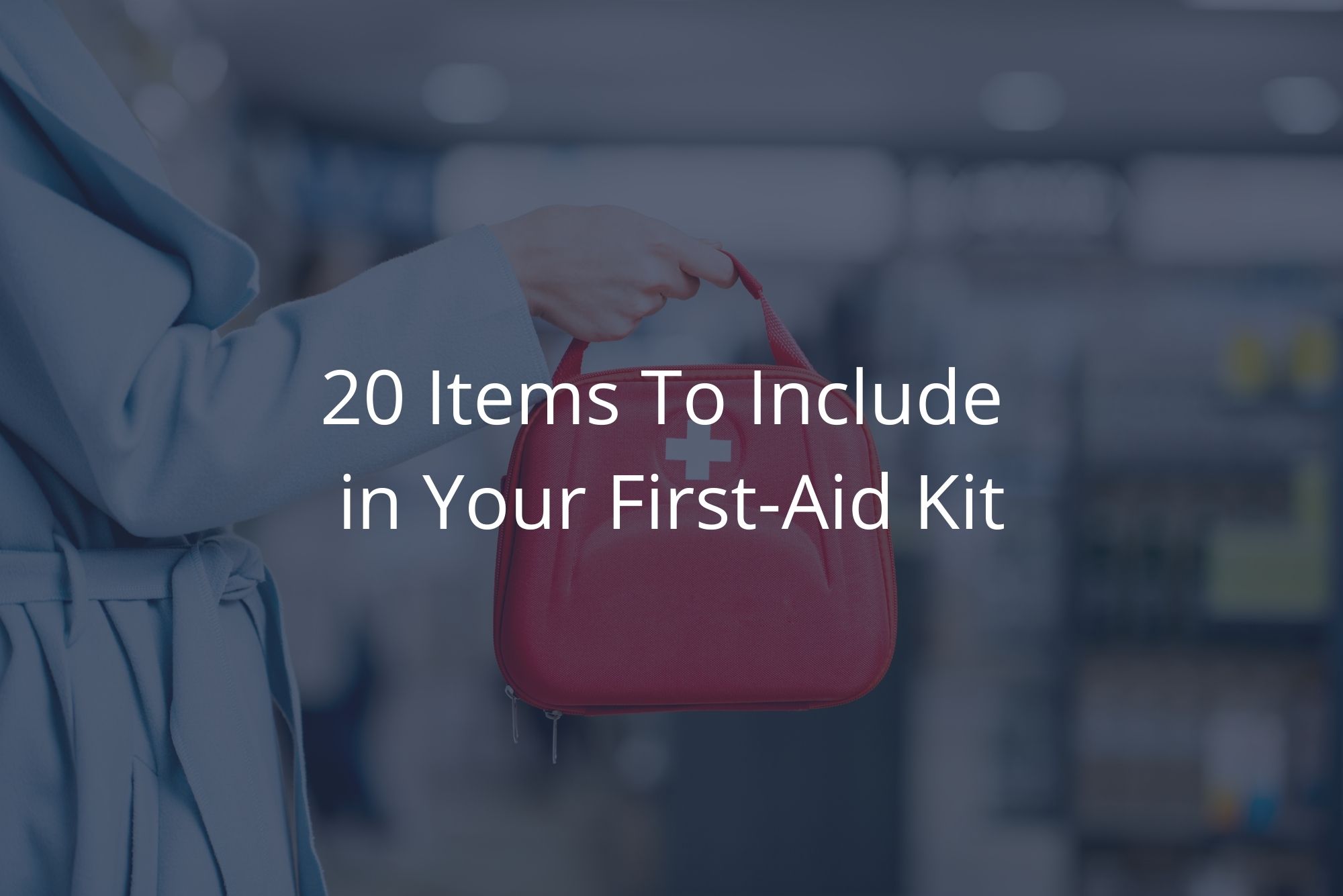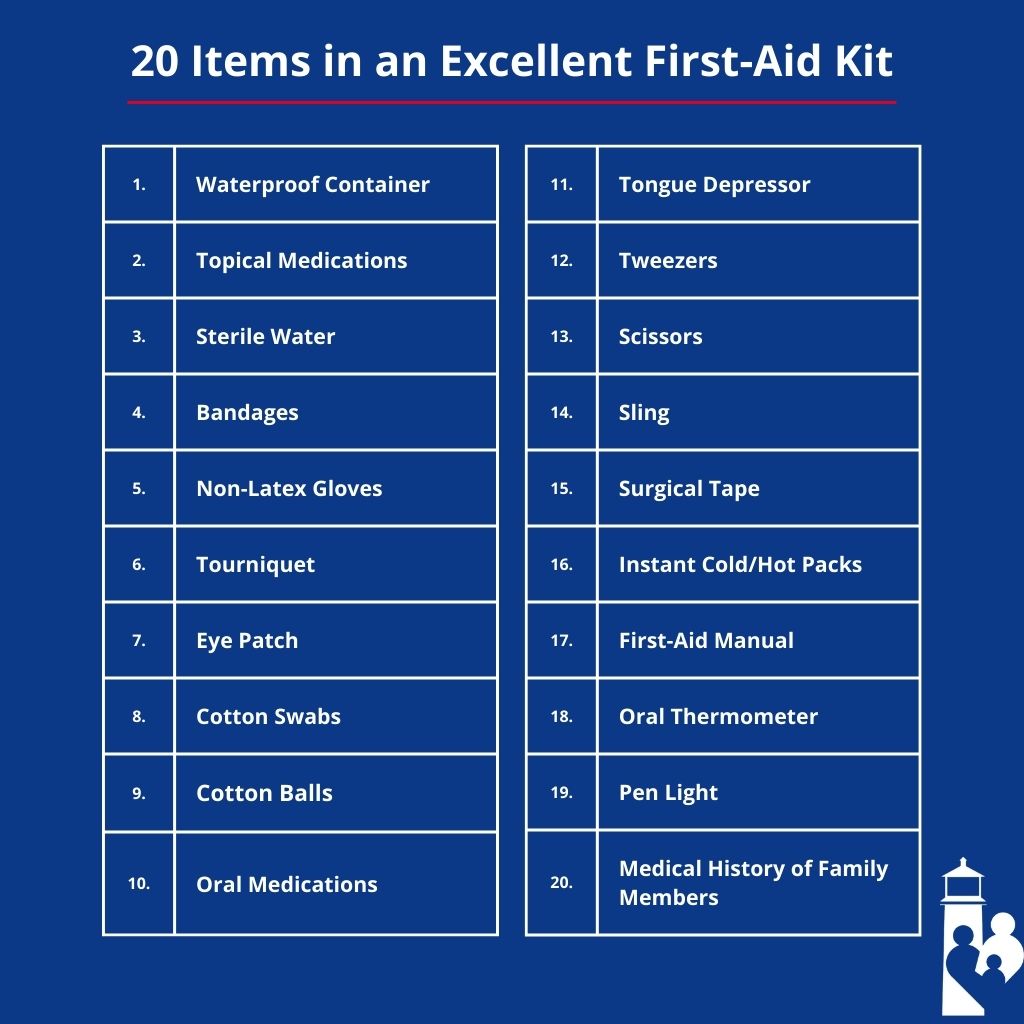
It’s 4:53 p.m. on a Friday afternoon. You wrapped up your work day early and are looking forward to unwinding. Your 5-year-old son, delighted to see you, comes dashing down the sidewalk to wrap his spindly little arms around you in a hug. In his eagerness, he trips and skids across the concrete on his knees and chin.
Or maybe it’s 2:52 a.m. and you wake up with a stomachache signaling you need the bathroom — five minutes ago. On your way there, you step on a splinter.
When life goes awry like this, it’s hard to think clearly. Your thoughts can range from colorful language to blankness. You can even panic, depending on the circumstances. In situations like these, you’ll thank yourself if you have a fully stocked, easily accessible, and thoughtfully appointed first-aid kit.
Here are my recommendations for 20 items in an excellent first-aid kit for the home. (See my tips on a travel first-aid kit in another post.)
1. Waterproof Container
Before we get into the contents of your kit, let’s talk about how and where it’s stored. A kit that you can’t find, can’t open, can’t close, or can’t carry isn’t all that helpful. Neither is a container that can’t stand up to brusque movements or getting wet.
To keep the contents of your kit contained and unspoiled, invest in a durable, waterproof container — with a handle if you can find one. Store your kit in one, designated location.
Make sure the adults in the house know where the kit is so they can grab the handle at a moment’s notice and take it wherever it needs to be — like that sidewalk where your son is crying. Also, make sure the kit is inaccessible to small children.
2. Topical Medications
These beauties are helpful for skin wounds — either to clean them and prevent infection, or to treat an existing infection. As always, you’ll want to have your injury looked at by a professional, but if it’s not life-threatening, go ahead and patch it up on your own.
Some great options to add to your first-aid kit include:
- Betadine, isopropyl alcohol, and antiseptic wipes to clean wounds.
- Antibiotic ointments like Bacitracin or Polysporin to prevent skin infections.
- Mupirocin is a more powerful prescription antibiotic your doctor may prescribe and have you stock in your kit to treat skin infections.
- BleedStop powder to stop bleeding.
3. Sterile Water
Sterile water is useful for cleaning minor wounds — a practice commonly called “irrigation.” Ask your physician or pharmacist for a bottle of sterile water.
4. Bandages
When it comes to bandages, the more the merrier. Get yourself an assortment of sizes and types to fit a variety of locations and needs.
- Assortment of bandage size and shapes.
- Sterile gauze.
- Non-sterile gauze.
- Coban bandage — a sticky, self-adhesive wrap useful for stabilizing sprains or covering a broad area. It sticks to itself, not your skin.
5. Non-Latex Gloves
These protect your hands from the body fluids of others, and they protect the wounds of others from the germs on your hands. I suggest non-latex because some people have sensitivity or allergy to latex.
6. Tourniquet
This falls into the category of May You Never Need This, but it’s a relief to have one if you do need it. You can buy tourniquets online and save yourself the pain of having to improvise one on the spot.
7. Eye Patch
An eye patch is handy if you think you’ve gotten something in your eye that you can’t get out. The patch will prevent you from blinking and causing further irritation. It’s also useful for eye pain.
8. Cotton Swabs
Excellent for applying antibiotic creams or antiseptics to small wounds without using your fingers.
9. Cotton Balls
Also helpful for applying ointments or antiseptics to larger wounds.
10. Oral Medications
It’s useful to have a smattering of over-the-counter oral medications on hand for a variety of ailments. Here are my top picks:
- Benadryl — for allergic reactions and allergies.
- Aspirin — for suspected heart attack.
- Ibuprofen — for pain relief, and inflammation and fever reduction.
- Tylenol/Acetaminophen — for pain relief and fever reduction.
- Ipecac — to induce vomiting in the event of oral overdose of toxins, poisons, or medications.
- Pepto-Bismol — to ease upset stomach and diarrhea.
- Imodium — to stop diarrhea.
11. Tongue Depressor
This one may seem a little strange, but it’s a handy item to add to your kit. You can use a tongue depressor as a tongue depressor if needed, but more commonly I find them useful as splints.
12. Tweezers
For the removal of ticks, splinters, or other debris from your skin.
13. Scissors
To cut bandages to size or for many other unpredictable uses.
14. Sling
To support an injured upper limb.
15. Surgical Tape
Surgical tape is excellent for taping on gauze patches when you have to make a custom bandage. I recommend using hypoallergenic, non-latex tape to keep down the risk of skin irritation or reaction.
16. Instant Cold/Hot Packs
Cold packs are useful for reducing immediate swelling and pain in injuries like a sprained ankle. Hot packs can help with cramps and stiffness.
17. First-Aid Manual
Very few people know the best way to manage every medical situation at home, so a first-aid manual is invaluable. Look for one with easy-to-understand directions and clear illustrations or photos. Remember, you won’t necessarily be thinking clearly when you need to use it, and you may be acting under pressure. Keep it simple.
18. Oral Thermometer
A non-mercury, non-glass thermometer will last longest without the need for battery changes.
19. Pen Light
A pen light is a small, slim flashlight about the size of a pen. They’re easy to find online, and are a great addition to the kit. The small diameter of a pen light makes it ideal for looking into throats — for a stuck object, for example, or to see if the tonsils are infected with pus. They’re also handy for looking into ears or at cuts.
20. Medical History of Family Members
An excellent addition to any first-aid kit, a family medical history will provide on-the-spot pertinent — and potentially life-saving — medical information for every member of the family. It should include things like individual diagnoses, surgical history, allergies, and medication lists. The medication lists should include name, brand, dosage, and frequency for each medicine, prescription or over the counter.
Remember to Stay Up to Date
Finally, be sure the contents of your kit stay in-date and functional. When you notice you’re getting low on an item, immediately replenishing your stock is a safe way to go. You can also set yourself an annual inventory day to check on expiration dates.
There’s no way to avoid all of life’s inconvenient medical events, but including these 20 items in your first-aid kit can help you manage the bumps.

Dr. David Rosenberg
Dr. Rosenberg is a board-certified Family Physician who obtained a BS in Chemistry at Georgia's Mercer University in 1983 and a medical degree from the University of Miami in 1988. He completed his residency in Family Medicine at The Washington Hospital in Washington, Pennsylvania, in 1991 and then practiced Emergency Medicine at Palm Beach Gardens Medical Center for two years. In 1993 he started private practice in Jupiter.
Dr. Rosenberg has been married to his wife Mary for 38 years and they have three grown children together. Some of his interests include being a huge baseball fan, sailing, snow skiing, self-development, and learning to play piano.

